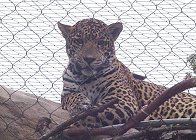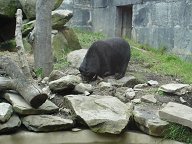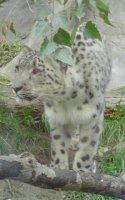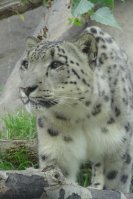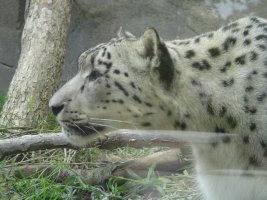A Visit to the Akron Zoo |
|||||
|---|---|---|---|---|---|
| Not having gone on any adventures last month, Jim and I started out our October fun early with a trip to the Akron Zoo, on the second day of the month. Although much smaller than the Cleveland Metro Parks Zoo, we really liked this little zoo, which was kind of like a Discovery Place mixed with a zoo and a little bit of botanical gardens throw in for good measure. All the animals are kept in very natural looking habitats, and the walkways through the zoo are decorated in Amazon/Mayan Temple motif. The Akron Zoo is one of 211 accredited world conservation zoos, which participate in breeding programs to save endangered species. | |||||
 |
|||||
|
The information about the animals in the Akron Zoo is taken from: http://www.akronzoo.org/ |
|||||
 |
Humboldt penguins are warm climate penguins, unlike their Antarctic relatives. Humboldt penguins inhabit areas with more temperate climates like Peru and Chile. The Humboldt penguin is currently an endangered species. Some estimates indicate the possibility of extinction in the wild in the next 10 years. | ||||
MouseOver each of us for a CloseUp |
|||||
 |
Throughout the zoo, the streams and small areas between the exhibits are filled with various smaller animals and water fowl. | ||||
| Lemurs are thought to be the oldest living representative of the primate order and mainly live on the Island of Madagascar. Scientists know of 34 different species of lemurs that exist today. | |||||
 |
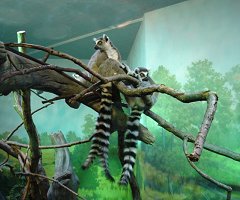 |
||||
| The black and white ruffed lemur is another one of the endangered species. |
 |
||||
| Llamas (as seen in the first picture) and other members of the Camelid family, such as Alpacas (the second picture), are native to the south American Andes in Peru, Chile, Bolivia and Ecuador. The Alpaca Owner and Breeder Association (AOBA) started the alpaca registry in 1988. This organization is dedicated to increasing the awareness of these animals; to educate people on proper care and breeding practices of alpacas and to promote the growth of the alpaca industry as a whole. Alpacas must be blood typed in order to be registered and nearly every alpaca in the U.S. is registered. | |||||
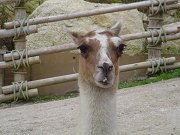 |
 |
||||
 |
Andean Condors come from the open areas and
rocky cliffs of the Andean mountain region of South America. With an adult
wingspan of about 10 12 feet, they are the largest flying bird in the
world. In 1973 they were listed as endangered by U. S. Fish and Wildlife
Service. Biologists estimate that there are only a few thousand of these in
the wild. They are a part of the American Zoo and Aquarium Association (AZA)
Species Survival Plan program (SSP). MouseOver for a CloseUp |
||||
| Jaguars are the largest cats in the Americas. US Fish & Wildlife Service lists jaguars as Endangered. Jaguars are a part of a Species Survival Plan (SSP) with the American Zoo and Aquarium Association (AZA). Although jaguars seem to be identical to leopards, there are several ways to distinguish between the two. The coat of the jaguar has larger rosettes in smaller numbers. The rosettes are usually darker, have thicker lines and enclose smaller spots. Leopard rosettes are usually smaller, more faint and more abundant. The build of a jaguar is overall more muscular than the leopard. The head of the jaguar is more square and the legs are more stocky than those of the leopard. | |||||
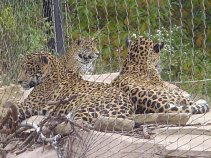 |
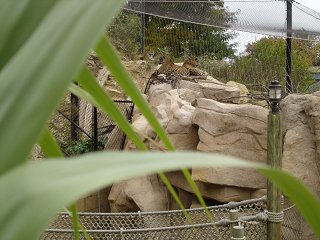 |
||||
| As I mentioned, this zoo is laid out with a very nice jungle temple motif. Behind the jaguar enclosure, the zoo has a rope bridge crossing a ravine adding to the Amazon theme. As you cross this bridge, the jaguars are only about 10 feet away, sunning themselves on the rocks - and wondering how tasty you are! | |||||
|
|||||
 |
 |
||||
| MouseOver CloseUps of Jim and I at the Zoo | |||||
 |
|||||
| The Hyacinth Macaw is predominantly colored a deep cobalt blue; but they have a golden eye ring and a golden stripe on their lower mandible. This yellow color is actually the color of the birds skin, which shows through where they have no feathers on their heads around their eyes and beak. |
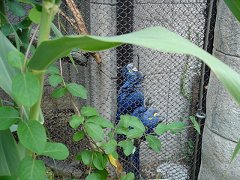 |
||||
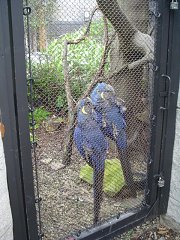 |
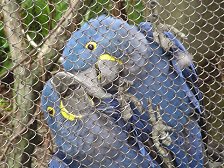 |
||||
| This darkened building houses the Rodrigues fruit bat, the Seba's short-tailed bat, the Straw colored bat , and the Jamaican fruit bat. |
 |
||||
| Along with the bat exhibits, there
were several other displays of various other reptiles and amphibians which are nocturnal. |
|||||
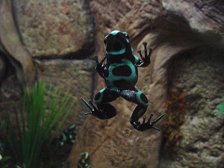 |
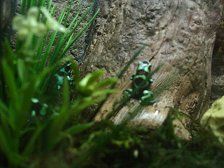 |
||||
| The Himalayan Tahrs are close relatives to the wild goat. In the Himalayans the tahrs only predators are the snow leopard and humans. Their life span is about 10 14 years in the wild, but they can live over 22 years in captivity. Accidental deaths do occur, in the wild, due to rock slides or avalanches. | |||||
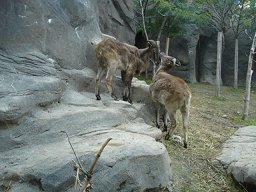 |
|||||
| While I was taking pictures of the tahrs, Jim was taking pictures of me! | |||||
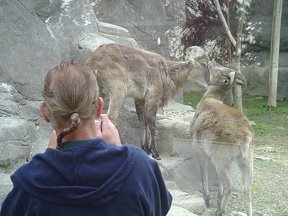 |
 |
||||
| The Greater African flamingo is the largest type of flamingo with males standing at about 5 feet tall. When feeding, flamingos lower their head to the water, almost turning it upside down. The head is moved back and forth while water is pumped in and out of the bill with the tongue. The water is forced out while invertebrates are trapped within the beak. | |||||
 |
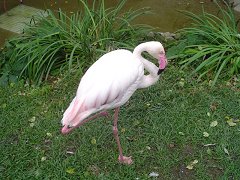 |
||||
| Komodo dragons are native to the southeastern islands of Indonesia and are the largest lizards in the world. Despite their size, komodos are fast moving, good climbers and like all monitor lizards, they are good swimmers. They can run about 11 miles per hour, which is about as fast as a human. An animal that has been bitten by a komodo will not survive long. It could take hours or as long as a week or two for the animal to die. The saliva of komodos contains about 50 species of bacteria, at least seven of which cause severe blood poisoning. The life span of a komodo in the wild is estimated at 50 years. In captivity, they have lived to be more than 25 years old. Usually, captive animals live longer than animals in the wild because they do not have to deal with the hardships of hunting, predation and natural disasters. Recent studies have shown that dragons kept in captivity maintain a lower core body temperature of almost 4ēC, compared to wild dragons. This may make them more susceptible to disease. In the past, there has been a lack of knowledge about the care of komodo dragons, and it has been difficult to mimic their natural habitat. Komodo dragons are classified as endangered by the U.S. Fish & Wildlife Service and by the Convention on the International Trade in Endangered Species (CITES). | |||||
 |
 |
||||
| Also inside the Reptile Exhibit, were several different snakes including the Dumeril's ground boa. Another indoor display housed several North American River Otters and this African Crocodile pictured at the right. Scattered throughout the zoo were several turtle pens housing several types including the Galapagos Tortoise. |
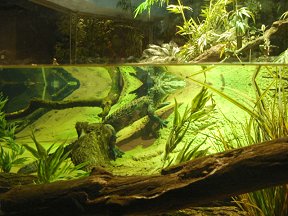 |
||||
| Malayan Sun Bears get their name from the yellow crescent on their chest. They are the smallest of bears and spend much of their time in trees. Sun bears sleep and sun bathe during the day because they are primarily nocturnal. These bears have a true "sweet tooth," because they seek out honey while foraging for fruit, insects and small mammals. | |||||
|
|||||
| Sun bears are highly endangered animals and are being driven to extinction by humans capturing cubs for pet trade, poaching for body parts for use in traditional Asian medicines, destroying habitat and fragmenting populations. The sun bear's former range included most of China, Southeast Asia and Indonesia. They are now believed to be extinct in China and India. | |||||
 |
The Zoo's tagline is "You've never been this close!" which is quite true. Nearly all of the very natural looking habitats include a glass wall looking into the enclosure. Unlike most zoos, where the visitors are separated from the animals by fences, large ditches, and up to 50 ft. of distance, at the Akron Zoo, quite often you can be mere inches away from the animals. This Sun Bear was probably less than a foot away from me when I took this picture through the glass. | ||||
| The Sumatran Tiger is the smallest type of tiger. Males weigh about 309 pounds whereas, a male Siberian tiger may weigh as much as 670 pounds. Most people do not realize that no two tigers have the same stripe pattern. Sumatran tigers have the most stripes of any tiger covering its body. | |||||
| Once again, a simple glass wall allowed us to be mere inches away from the tiger. MouseOver this picture to see how large this kitty's paws are. |
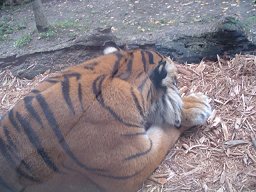 |
||||
| Although the tiger was quite content just lying in the straw surveying his domain, we did hear him defending his territory. A small chipmunk darted through the tiger's enclosure and he roared several times at the small rodent. The chipmunk quickly scampered through the area as the tiger voiced his displeasure. | |||||
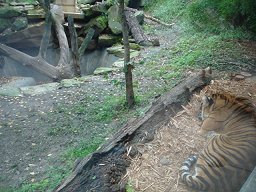 |
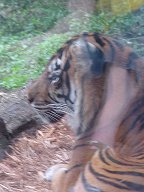 |
||||
| MouseOver the picture below to see
the tiger up close in his enclosure, as he watches the chipmunk go through his area. |
|||||
 |
|||||
| Jim gets up close and personal, trying to get a good shot of the tiger | |||||
 |
|||||
| The White-Handed Gibbon, also known
as the Lar Gibbon, are found in pockets of forest in south east Asia, the Malay peninsula and northern Sumatra. |
|||||
 |
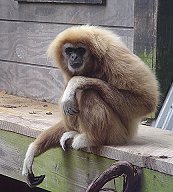 |
||||
 |
|||||
| Looking around from a deck along
the zoo's walkway, you could never tell that only a short distance away is I-77 and a neighborhood full of people and traffic. |
|||||
 |
 |
||||
| Don't I look cute? Don't you want to pet me?
Don't worry, just ignore that sign over there. LOL (sign reads: "Caution: I bite!") |
|||||
| Red Pandas are known by different names. The
Chinese call them WAH. They also are known as fire fox. Red pandas inhabit
forested mountain regions in China where temperatures get extremely cold, so
these guys are probably quite happy here in Ohio in the Winter. MouseOver CloseUp |
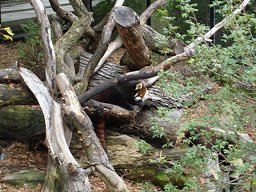 |
||||
| The Trumpeter Swan, which lives in Alaska, the western coast of Canada, the state of Washington and Northwest Wyoming, were nearly driven to the brink of extinction at the turn of the 20th century. They were easy to kill because they lose their wing feathers and become flightless for one month each summer. Fortunately, in 1918 the U.S. Federal Government passed the Migratory Bird Act, which made it illegal to hunt these and other migratory birds. | |||||
 |
|||||
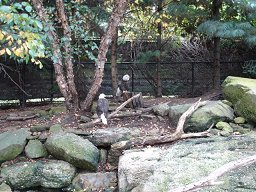 MouseOver CloseUp |
When settlers first arrived in Ohio,
American
Bald Eagles were very common along Lake Erie, major river systems and inland
marshes. But, over the years their numbers began to dwindle due to hunting,
pesticides and habitat destruction. In 1990, only 10 bald eagle nests were
active and fewer than 30 birds were living in Ohio. Fortunately, through
public education and the protection under State and Federal laws, Ohio's
eagles are increasing in numbers. In 1998, 30 eagles hatched successfully. |
||||
| The nest of an eagle is no small matter and the birds return to the same nest year after year to raise their young. The largest nest ever recorded in Ohio was located in Vermillion. The nest was 12 feet high, 8 1/2 feet wide and weighed nearly two tons. It was used for more than 35 years until it fell 80 feet to the ground during a storm in March of 1925. | |||||
| The Zoo is divided into several sections, including "Legends of the Wild", "Komodo Kingdom", "Tiger Valley", "Maxene's Asian Trail, and the "Wild Prairie". Along with all those animals exhibits, the Zoo boasts a beautiful botanical garden thanks to the contributions of the Lehner Family. | |||||
 |
 |
||||
| Standing behind the fountain looking across the gardens | Looking at the fountain from the other side of the garden | ||||
 |
|||||
| After strolling through the gardens, I am anxious to return to this zoo next year. I definitely want to visit earlier in the year when the plants are in full bloom. Although many of the plants were still flowering, you could tell it was late in the season and the plants were beginning to die out. I was happy to see that all of the plants were labeled with their names - both the Latin name and the common name. I found out that the ornamental grass I have planted behind the fountain in my front yard is called "Sheep's Fescue". | |||||
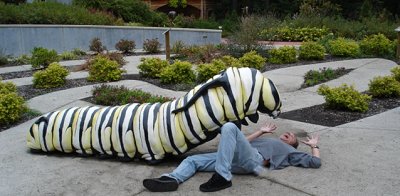 |
|||||
| Attack of the Killer Caterpillar! | |||||
 |
One of the reasons we thought to visit this zoo
was because of all the pictures that we had seen when Tara and Austin had
visited the zoo. When they visited, this exhibit had prairie dogs, while the
pen was filled with rabbits on our visit. MouseOver my picture for a CloseUp |
||||
 |
|||||
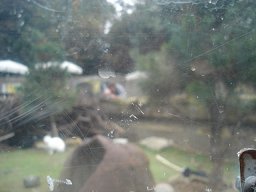 |
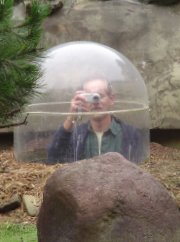 |
||||
| This is my picture from inside the bubble | |||||
| Jim looks out at the bunnies . . . | . . . and at me making faces at him! | ||||
 |
 |
||||
| The Snow Leopard comes from the mountains of Central Asia, specifically the Himalayas, Altai and Hindu Kush. Due to their excellent camouflage, elusive behavior and small numbers, snow leopards are rarely seen in the wild and are difficult to study. This leopard is crepuscular, active during dusk and dawn. It has been estimated that there are about 3,500 to 7,000 left in the wild. There are about 600 700 in zoos around the world. The snow leopard has been categorized as an endangered species by the World Conservation Union (IUCN) since 1972 and is protected by the Convention on International Trade in Endangered Species of Wild Fauna and Flora (CITES Appendix I), which makes trafficking live cats, fur or body parts illegal. | |||||
| When we first saw the Snow Leopard, he was prowling the back section of his habitat. However, something caught his eye and he stealthily moved underneath some low-hanging tree branch and began to move to the front of his territory. | |||||
|
|||||
| Yikes! It was ME
that had caught the attention of the big cat! |
|||||
 |
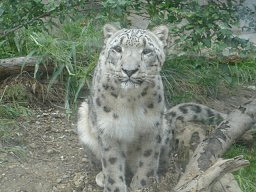 |
||||
| Mmmmm. You do look tasty! | |||||
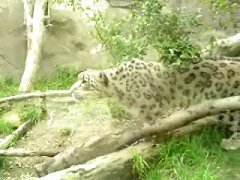 |
Click this picture to watch the big kitty stalk me! |
||||
| Thanks to the glass, I wasn't eaten by the Snow Leopard, so Jim and I both really enjoyed this trip to the Akron zoo. We got to get "up close and personal" with the animals ,along with enjoying the beautiful flowers, plants, and trees in the gardens and throughout the Zoo. If you're in the area, I highly suggest taking a trip to visit this Zoo. It's not too large, so you won't be tired from a long trek (like visiting the huge Cleveland Zoo). Being able to get so close to the animals is a big plus for a nice visit. And, of course, the good layout of the park along with the jungle motif and natural habitat exhibits, really enhances the experience. |
 |
||||
| October 2, 2006 | |||||



